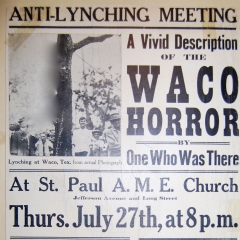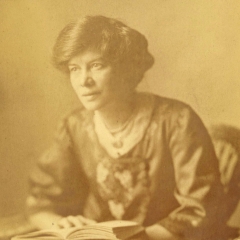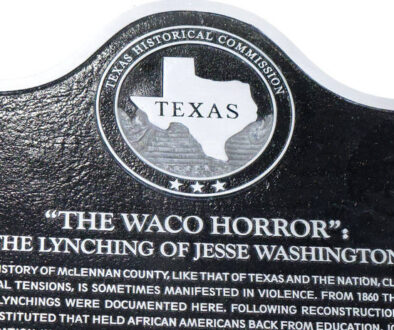Anti-Lynching in 1916
When Elisabeth Freeman showed her niece Ruthie (my mother) the scrapbook detailing her activism, she instructed her not to look at one section. “It was,” she said, “too terrible for a young girl.” * My mother ignored her warning but she was not wrong—there were gruesome images of the torture and lynching of a young black man in Waco, Texas in 1916.
The recent suspicious deaths of Robert Fuller and Malcolm Harsch, found hung from trees in California, have raised the specter of a modern day lynching. (Originally deemed suicides, the two deaths are now being investigated.)
Lynching was a tool of white supremacy during Reconstruction after the Civil War. It was, and is, terrorism and in 1892 alone 100 black men were lynched. By 1916, the nascent NAACP, formed by white and black activists, were desperate for a detailed investigation of a lynching to launch a nationwide anti-lynching campaign.NAACP staffer Roy Nash was tasked with getting ready for the next inevitable lynching so they could get someone on the scene quickly. Elisabeth ran into him on a train as she traveled to Texas where she was hired to generate interest in the Texas Woman’s Suffrage Association. She spent two months traveling the state, speaking, organizing and training activists.
On May 16, 1916, Roy Nash wrote her: “Will you not get the facts for us? Your suffrage work will probably give you an excuse for being in Waco…” She did get the facts and pictures, and all the machinations of local politics, mostly through her feminine wiles and creative investigating. The subsequent campaign used her report to recruit membership and build awareness about the violence against black people. (More here)
Upon arriving in Waco, one of the first things Elisabeth did was go to the black churches and apologize for white behavior. Then she visited white churches and asked them what they were doing about it. *
The story she uncovered belied the myth that lynchings were spontaneous acts by extremist racists in response to a perceived threat to white supremacy. Instead, Freeman discovered that the police, the courts, the whole town in fact, were in on it. The photographer set up his camera in advance. The court proceedings happened almost instantly, and the bailiff all but handed the prisoner over to the crowd. The gathered crowd numbered over 10,000 and had been waiting for this gruesome event in a party-like atmosphere. In other words, the apparatus of the government in Waco orchestrated, or certainly facilitated the death of Jesse Washington. For more on the lynching go here but trigger alert, the images are upsetting.
White women suffragists were not known for their support of black suffragists. Just 3 years earlier Ida Wells Barnett organized black women in a suffrage club which was denied participation in the national suffrage march in Washington DC. Elisabeth herself tried to promote mutual understanding and support between the Columbus Ohio Suffragists and the Women’s Auxiliary of the Columbus NAACP to no avail.
After she made her report to the NAACP, Elisabeth agreed to two tours going from city to city speaking out against lynching, mostly to black audiences to support the NAACP campaign. She was often referred to as the “plucky English suffragette.” As a result of her experience she was recruited to the Charles Evans Hughes Campaign Train where she spoke to largely black audiences.
Today, with the increasing popularity and strength of Black Lives Matter and greater awareness of white privilege, it’s hard to contextualize the dynamics between a white female activist and the black communities she addressed 100 years ago.
What we do know is that Elisabeth had a strong sense of justice from an early age. She was attracted to the Salvation Army for this reason, and of course, to the British suffragette movement and her commitment to working women and men. My mother relayed an anecdote that offers a clue: When Elisabeth was in school, she committed some infraction (probably talking when she wasn’t supposed to) and as “punishment” she was made to sit at the same desk as a black girl. She was outraged at the prejudice and happily sat with her. *
*Interview with Ruth Freeman Johnston, 2004







